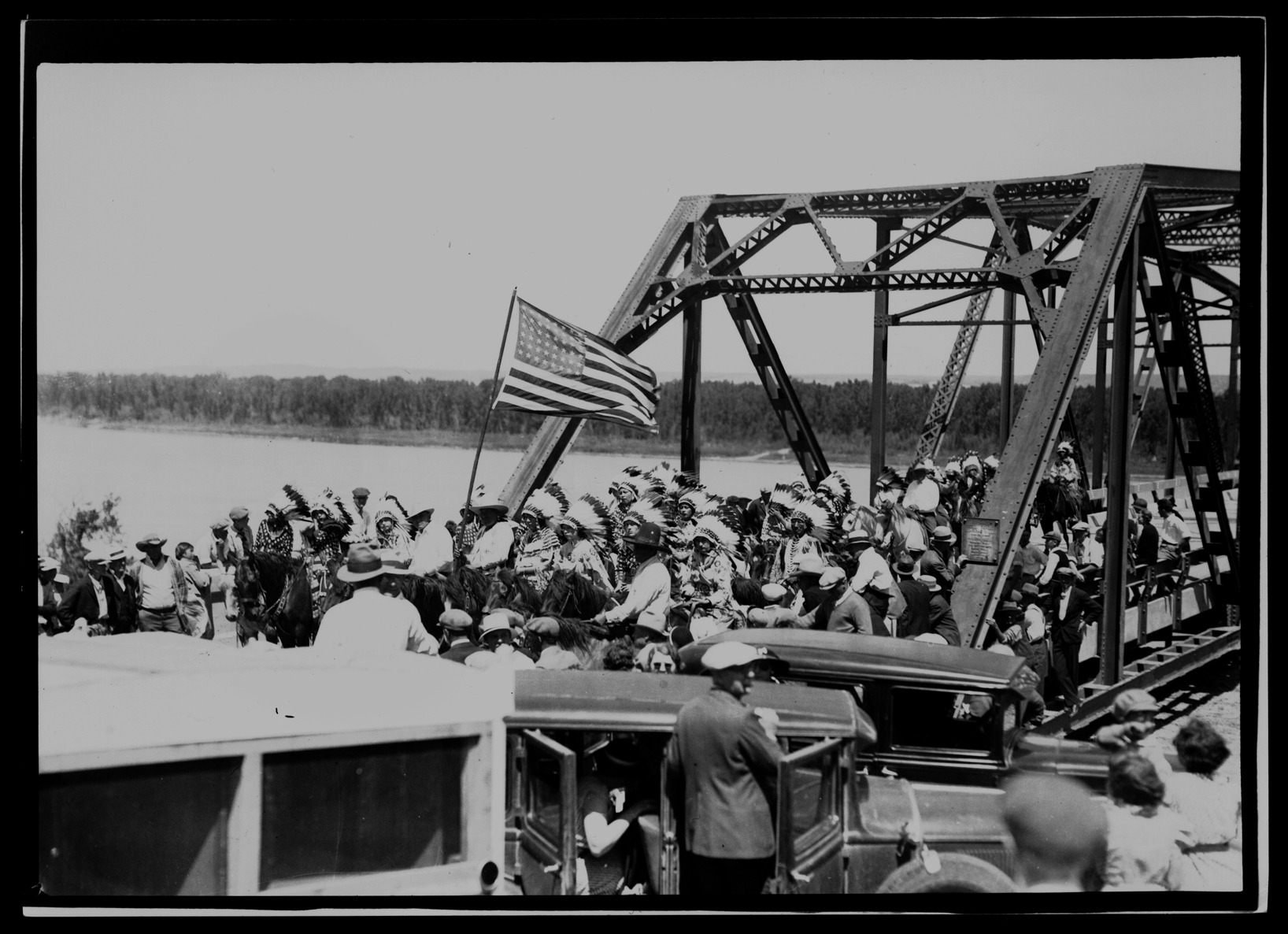This image may be restricted. Contact reference staff for assistance.Collection: 2019P162 - Leo D. Harris Photo Collection
Folder: 0001
Item: 00030
Title: Attendees to the Four Bears Bridge dedication ceremony parade cross new Four Bears bridge, Elbowoods (N.D.)
Date: 6/17/1934
Creator: Harris, Leo D
Summary: Fox Society women on horseback including Alison Grinnel dressed in regalial, and other dignitaries from Fort Berthold parade across the new Four Bears bridge opening it after the dedication. One man is carrying the American Flag. Automobiles are off to the side and people are in the cars and standing on the running boards. One man is closely examining the plaque bearing the bridge's name which is affixed to the bridge. [History] The Four Bears Bridge was originally constructed in 1934. The bridge replaced Verendrye Bridge, and spans the Missouri River on the Fort Berthold Indian Reservation. The bridge was moved in 1955 due to the construction of the Garrison Dam and subsequent creation of Lake Sakakawea. A new Four Bears Bridge was constructed in 2005. Because the Mandan tribe lived on the south side of the river, the south end of the bridge was dedicated to the Mandan Chief Four Bears (Mato Tope). A two-story monument near the entrance of the bridge was dedicated to the Mandan chief. The Hidatsa lived on the north side of the river, and the north end of the bridge was dedicated to their Chief Four Bears, who was recognized as a diplomat and was instrumental in the signing of the Fort Laramie Treaty of 1851. The treaty included transportation access through the reservation. The Chief was killed by the Sioux in the fall of 1861, while he was bathing in the river. Cain, James Patrick—1882-1943 __Mato-tope (also known as Ma-to-toh-pe or Four Bears, from mato "bear" and tope "four") (c. 1784[6] - July 30, 1837) was the second chief of the Mandan tribe to be known as "Four Bears," a name he earned after charging the Assiniboine tribe during battle with the strength of four bears. Four Bears lived in the first half of the 19th century on the upper Missouri River in what is now North Dakota. Four Bears was a favorite subject of artists, painted by George Catlin and Karl Bodmer.
Chief Four Bears, Hidatsa (Awatiza) War Chief/Treaty Chief 1810-1861
Four Bears was born to Two Tails. He was also had rights in ownership of the Daybreak and Sunset Wolf ceremonial Bundles. Four Bears was a war Chief in the hard times after the 1837 small-pox epidemic that had ravaged the population of the Knife River Villages. Weakened and susceptible to attacks from their enemies the Dakota, who greatly outnumbered them and wanted to extend their territory north of the Heart River to include the large Painted Wood bottoms near present-day Washburn, North Dakota. By 1845, Four Bears had succeeded in convincing not only his own people but the Mandan and later in 1862 the Arikara to move into one new village further up the Missouri river that would be called Like-a-Fishhook village. He would become that village’s greatest war chief. In July 31st, 1851, Four Bears and a delegation representing the Mandan, Hidatsa and Arikara set out on a 1600 mile journey to speak at a gathering of Plains tribes to meet with the US Government and establish their territorial boundaries. The delegation left from Fort Union with the Assiniboin delegation, Alexander Culbertson (Agent in charge at Fort Union), and Fr. Jean-Pierre DeSmet (Jesuit Missionary) and followed the Yellowstone River south. By August 11th, the delegation had reached Fort Sarpy on the mouth of the Rosebud River and waited for the Crow delegation for about a week. The delegation continued their journey and finally arrived at Horse Creek on September 8th, 1851. On the 17th the delegation signs the treaty with the United States. The Fort Laramie Treaty was written, establishing a reservation for the Gros Ventres (Hidatsa), Mandan and Arikara. Four Bears signed for the Hidatsa, Iron Bear signed for Arikara and White Wolf for the Mandan. Four Bears became the "keeper" of a copy of the Treaty" that was painted on a buffalo hide. In preparation for the Treaty signing Poor Wolf had helped define the boundaries of Hidatsa lands according to tradition and stories associated tribal bundles. Four Bears would be killed while swimming near Fishhook Village in 1861. A number of monuments have become landmarks at the For Berthold Indian Reservation dedicated to the War Chief and protector of Like-a-Fishhook village now stands in front of the Three Affiliated Tribes Museum.
Red ID: PH_I_149336 Image ID: 175622 Image Notes: 2019-P-162-00030


